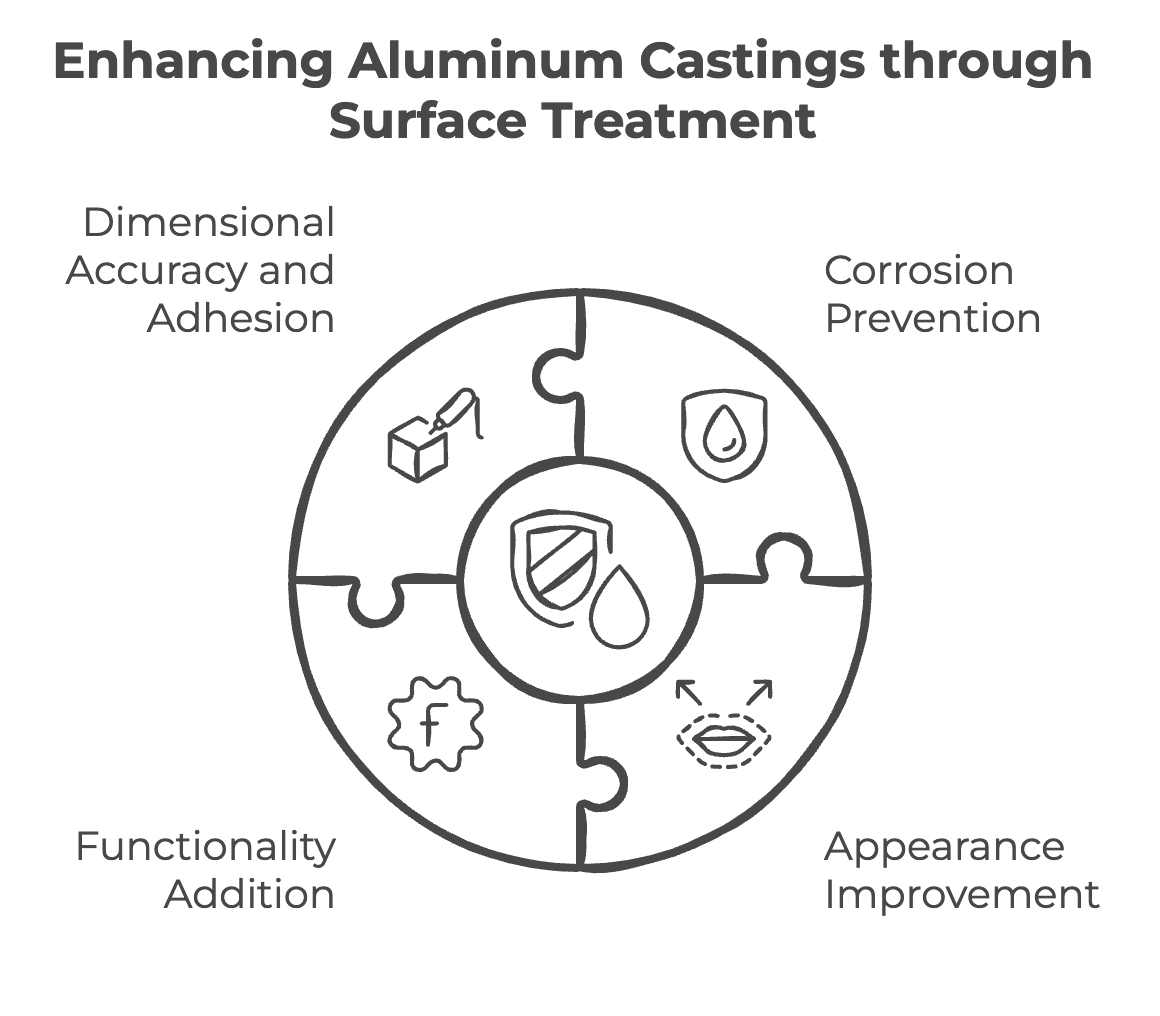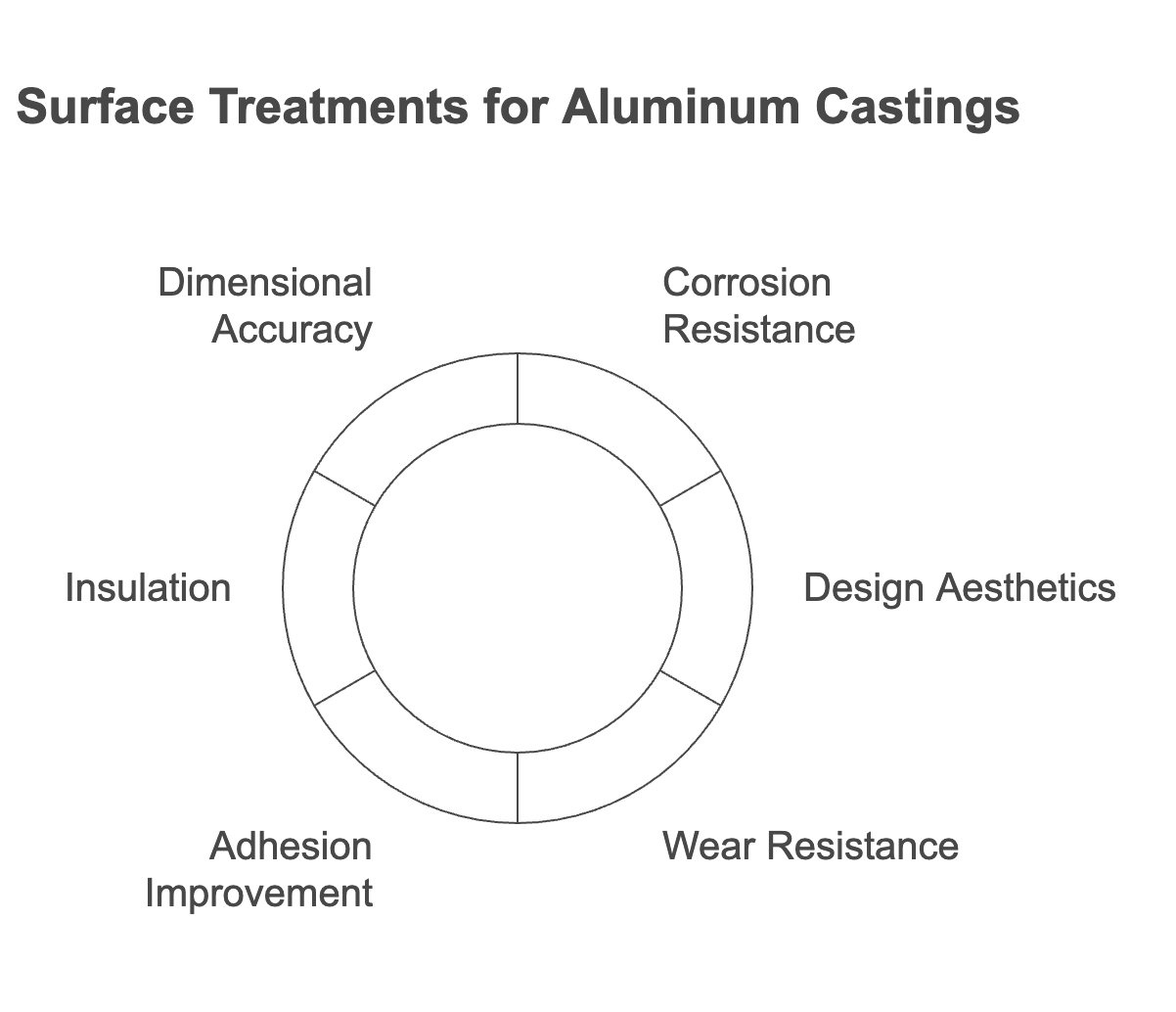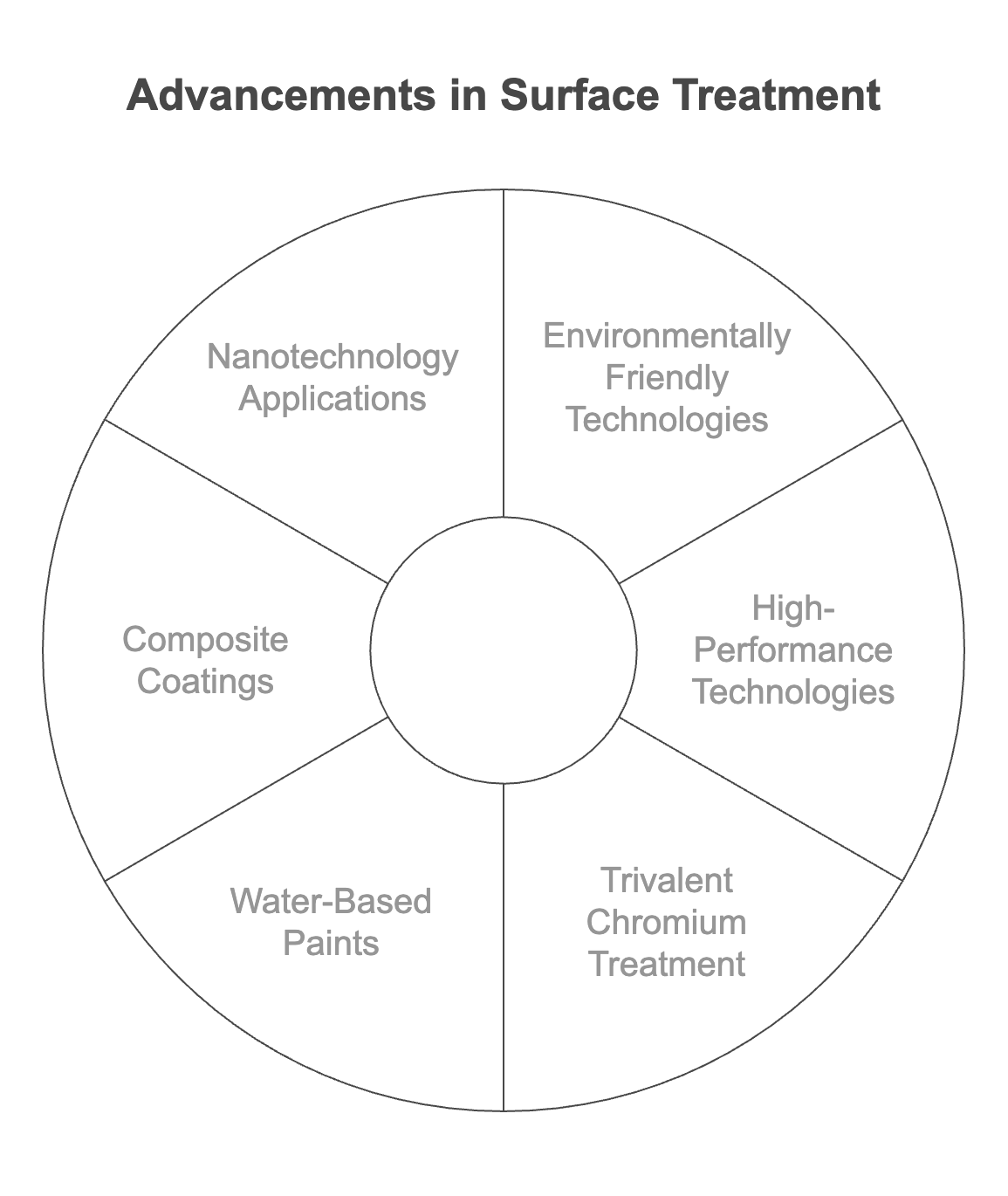◆Table of contents
ToggleIntroduction
Aluminum castings are used in various industrial fields because they are lightweight and easy to process. However, in order to maximize their characteristics, proper surface treatment is essential.
In this article, focusing on the surface treatment of aluminum castings, under the title “Surface Treatment of Aluminum Castings: Recommended Technologies and Cost Estimates by Purpose,” we will explain in detail the necessity, types, recommended technologies by purpose, cost estimates, and precautions for surface treatment of aluminum castings.
Surface treatment of aluminum castings plays an important role not only in improving the quality and life of products, but also in adding design and functionality. By selecting the appropriate surface treatment, it is possible to further enhance the value of the product.
Why is surface treatment necessary?
Aluminum castings have excellent properties such as being lightweight and easy to process, but they also have some drawbacks. One of them is the fragility of the surface.
Aluminum is a relatively rust-resistant metal, but it can corrode in acidic or alkaline environments, which can impair its strength and appearance. It also has the weakness of being easily scratched and worn because of its soft surface.
Therefore, surface treatment is essential to enhance the durability and functionality of aluminum castings.
The main purposes of surface treatment are as follows:
Corrosion prevention (improvement of corrosion resistance)
By applying alumite treatment or plating treatment, a protective film is formed on the surface of the aluminum casting to suppress corrosion. This can extend the life of the product.
Appearance improvement (improvement of design)
By applying painting or plating treatment, the appearance of the aluminum casting can be beautified. It is also possible to enhance the design of the product by increasing the color variations.
Addition of functionality
Depending on the type of surface treatment, various functions can be added to the aluminum casting. For example, hard alumite treatment improves wear resistance, and conductive plating imparts conductivity.
Others
Surface treatment is also used to improve the dimensional accuracy and adhesion of aluminum castings.
If surface treatment is not applied, aluminum castings may deteriorate prematurely due to corrosion and wear, and may lose their value as a product. In addition, the appearance and functionality will also be impaired, which may reduce the quality and competitiveness of the product.
As you can see, surface treatment is a very important process for improving the quality and life of aluminum castings.
Types of Surface Treatment for Aluminum Castings
Surface treatment of aluminum castings is performed in various ways to improve the quality and function of products. Here, we summarize the types of representative surface treatments, including their outlines, characteristics, advantages, and disadvantages.
1. Chemical Conversion Treatment
Chemical conversion treatment is a treatment that forms a film on the surface of an aluminum casting by utilizing a chemical reaction. It is mainly performed for the purpose of improving corrosion resistance.
| Type | Outline | Characteristics | Advantages | Disadvantages |
|---|---|---|---|---|
| Chromate Treatment | Immersed in chromate solution | Improved corrosion resistance and paint adhesion | Inexpensive, simple | High environmental load (hexavalent chromium) |
| Phosphate Treatment | Immersed in phosphate solution | Improved corrosion resistance and wear resistance | Relatively inexpensive | Thin film |
2. Coating
Coating is a treatment that applies paint to the surface of an aluminum casting for the purpose of improving design and imparting corrosion resistance.
| Type | Outline | Characteristics | Advantages | Disadvantages |
|---|---|---|---|---|
| Powder Coating | Electrostatic coating with powder paint | Thick coating film, high durability | Uniform coating film, abundant color variations | Requires equipment investment |
| Liquid Coating | Spray coating with liquid paint | Smooth surface finish | Various paints can be selected | Thin coating film, low durability |
3. Anodizing Treatment
Anodizing treatment is a treatment that electrochemically generates an oxide film on the surface of an aluminum casting. It is excellent in improving corrosion resistance, wear resistance, and design.
| Type | Outline | Characteristics | Advantages | Disadvantages |
|---|---|---|---|---|
| Anodizing Treatment | Anodic oxidation in sulfuric acid solution | Improved corrosion resistance, wear resistance, and design | High hardness, can be colored | Takes time to process |
| Hard Anodizing Treatment | Anodizing treatment under severe conditions | Extremely high wear resistance | Can be used even in harsh environments | High cost |
4. Plating Treatment
Plating treatment is a treatment that electrochemically deposits a metal film on the surface of an aluminum casting. In addition to improving corrosion resistance, wear resistance, and design, it is also possible to impart conductivity and magnetism.
| Type | Outline | Characteristics | Advantages | Disadvantages |
|---|---|---|---|---|
| Nickel Plating | Electroplating in nickel salt solution | Improved corrosion resistance, wear resistance, and smoothness | Uniform film, high adhesion | High cost |
| Chromium Plating | Electroplating in chromic acid solution | Improved corrosion resistance, wear resistance, and gloss | High hardness, beautiful appearance | High environmental load |
5. Other Surface Treatments
In addition to the above, there are treatments that physically process the surface of aluminum castings.
| Type | Outline | Characteristics | Advantages | Disadvantages |
|---|---|---|---|---|
| Polishing | Grinding the surface with abrasive material | Smoothing the surface, imparting gloss | Beautiful finish | Difficult depending on the shape |
| Shot Blasting | Blasting steel balls, etc. | Adjusting surface unevenness | Improved surface hardness | Noise is generated |
| Barrel Polishing | Rotating abrasive material and work in a container | Deburring, chamfering | Mass production is possible | Low accuracy |
As mentioned above, there are various types of surface treatment for aluminum castings, each with different characteristics and uses. In order to select the optimal surface treatment, it is necessary to consider the product’s usage environment, required functions, cost, and the like.
Recommended Surface Treatment Technologies by Purpose
Choosing the optimal surface treatment technology for aluminum castings is crucial, as it depends on the product’s intended use and specific goals. Here, we will explore the recommended surface treatment technologies for various purposes, along with concrete examples.
1. When prioritizing corrosion resistance
Aluminum castings used in corrosive environments such as marine environments and chemical plants require high corrosion resistance.
Anodizing treatment
Anodizing is a treatment that electrochemically forms an oxide film on the aluminum surface. The oxide film is hard and has excellent corrosion resistance. In particular, anodic oxidation treatment forms a dense film and exhibits excellent corrosion resistance.
Plating treatment
Plating treatment is a treatment that forms a metal film on the surface of an aluminum casting. Nickel plating and chromium plating are not only excellent in corrosion resistance but also improve design.
Specific examples
- Ship parts used in marine environments
- Piping parts used in chemical plants
- Building materials used in coastal areas
2. When prioritizing design
Aluminum castings that require a beautiful appearance, such as automobile parts and decorative items, are suitable for surface treatments with high design.
Coating
Coating is a treatment that applies paint to the surface of an aluminum casting. It is often used when design is important because it can express rich color variations and textures. Powder coating has a thick coating film and is also excellent in durability.
Plating treatment
Plating treatment is a treatment that forms a metal film on the surface of an aluminum casting. Chromium plating has a beautiful luster and can create a high-quality feel.
Specific examples
- Car wheels
- Housings of home appliances
- Lighting fixtures
3. When prioritizing wear resistance
Aluminum castings used in environments where wear is likely to occur, such as machine parts and tools, require high wear resistance.
Hard anodizing treatment
Hard anodizing treatment is a treatment that forms an oxide film under even more severe conditions than anodizing treatment. The film is very hard and has excellent wear resistance.
Specific examples
- Parts of industrial machinery
- Tools for machine tools
- Parts of aircraft
4. Other purposes
In addition to the above, there are various other purposes for surface treatment of aluminum castings.
Improvement of adhesion
Chemical conversion treatment is used to improve the adhesion of paint and adhesives.
Imparting insulation
Anodizing treatment is effective when electrical insulation is required.
Improvement of dimensional accuracy
Electroless nickel plating forms a uniform film and has the effect of improving dimensional accuracy.
As described above, it is important to select the optimal technology for the surface treatment of aluminum castings according to the product’s intended use and purpose. By applying appropriate surface treatment, it is possible to significantly improve the performance and life of aluminum castings.
Market Price of Surface Treatment
The cost of surface treatment for aluminum castings varies greatly depending on various factors such as the type of treatment, size and shape of the material, amount of treatment, and required quality level.
Generally, chemical conversion treatment is relatively inexpensive, followed by anodizing treatment, painting, and plating treatment in that order. In particular, hard anodizing treatment and electroless nickel plating can be expensive because they require advanced technology and equipment.
Cost estimates are just a guideline, and the actual cost requires requesting a quote from a vendor.
In order to keep costs down, it is important to pay attention to the following points:
- Get quotes from multiple vendors and compare them
- Reduce the unit price by consolidating the amount of treatment
- Reduce the amount of treatment by devising the shape and size of the material
- Review the required quality level and do not demand excessive quality
It is also necessary to consider the cost-effectiveness. Even expensive surface treatment can lead to cost reduction in the long term if it improves the life and performance of the product.
In order to select the optimal surface treatment, it is important to comprehensively consider not only the cost but also the product’s usage environment, required functions, and durability. It is recommended to consult with a professional and consider the optimal surface treatment method.
Precautions for Surface Treatment of Aluminum Castings
Surface treatment of aluminum castings is an important process for improving the quality and function of products, but there are some precautions.
Material properties
Aluminum castings have different properties from wrought materials in terms of casting defects, surface roughness, and alloy composition.
Casting defects
If there are casting defects such as blowholes and porosity, the film may not be formed uniformly during surface treatment. In particular, in plating treatment, the plating solution penetrates into the blowholes and causes peeling.
Surface roughness
The surface of aluminum castings may be rougher than that of wrought materials. If the surface roughness is large, the adhesion of paint or plating may decrease or the appearance may be impaired.
Alloy composition
Depending on the type of aluminum alloy, the suitability of surface treatment may differ. For example, alloys with a high silicon content are prone to color unevenness in anodizing treatment.
Environmental regulations
Some of the chemicals used for surface treatment may have a high environmental load. For example, hexavalent chromium is regulated as a hazardous substance. Alternative technologies such as trivalent chromium and geomet have been developed to comply with environmental regulations.
Safety
Since surface treatment work handles chemicals and high temperatures, it is important to ensure the safety of workers. It is necessary to thoroughly wear protective equipment and take ventilation measures to improve the working environment. In addition, it is necessary to properly treat waste liquid and dispose of waste to reduce the burden on the environment.
When performing surface treatment of aluminum castings, it is important to consider these points, select an appropriate treatment method, and perform the work with safety in mind.
Latest Surface Treatment Technologies
With the growing awareness of environmental issues and the increasing sophistication of product functions, surface treatment technologies are constantly evolving. Here, we will focus on environmentally friendly technologies and high-performance surface treatment technologies from the latest surface treatment technologies.
Environmentally Friendly Technologies
Environmentally friendly technologies are technologies aimed at minimizing the impact on the environment.
Trivalent Chromium Treatment
Treatment using trivalent chromium is attracting attention as a technology that replaces conventional hexavalent chromium treatment. It has lower toxicity compared to hexavalent chromium and can reduce the environmental burden.
Water-Based Paints
The use of water-based paints, which use water as a solvent, is spreading instead of conventional solvent-based paints. It reduces the emission of VOCs (volatile organic compounds) and contributes to the suppression of air pollution.
High-Performance Surface Treatment Technologies
High-performance surface treatment technologies are technologies aimed at dramatically improving the performance of products.
Composite Coatings
This is a technology that combines multiple surface treatments to exhibit the synergistic effect of each advantage. For example, by combining anodizing treatment and fluororesin coating, it is possible to achieve both corrosion resistance and non-stick properties.
Application of Nanotechnology
Surface treatment technology that applies nanotechnology controls minute structures to achieve high-performance surfaces. For example, coating with nanoparticles can improve wear resistance and catalytic activity.
These latest technologies play an important role in achieving both environmental considerations and high performance of products. Further development of more innovative surface treatment technologies is expected in the future.
Summary
Surface treatment of aluminum castings is essential for improving product quality, such as corrosion prevention, appearance improvement, and functionality addition. The optimal surface treatment varies depending on the application and purpose, and consulting with a professional can help you choose a cost-effective method.



